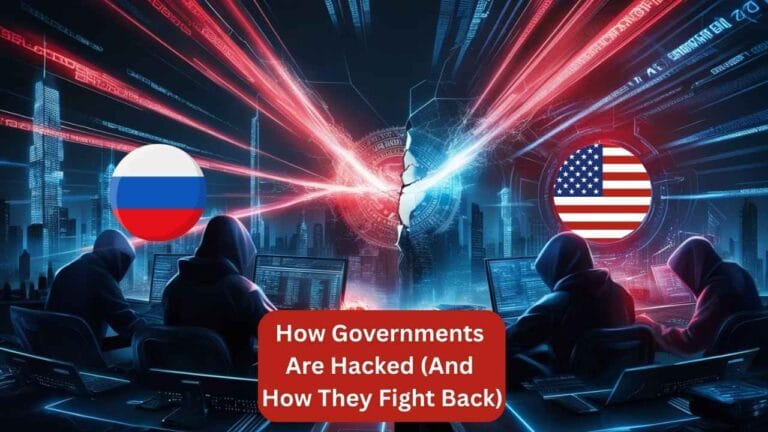Government systems are under constant cyberattack, but the real danger isn’t just hackers; it’s outdated defenses, human error, and invisible vulnerabilities. In 2024 alone, over 87% of national agencies reported attempted breaches, with attacks growing 300% more sophisticated since 2020 (MITRE Corp, 2024). The good news? Cutting-edge countermeasures are turning the tide.
As a cybersecurity consultant who’s helped federal agencies patch critical flaws, I’ve seen how a single phishing email can paralyze a department, and how simple fixes stop 99% of attacks. Let’s pull back the curtain on modern government hacking and the shockingly straightforward ways institutions are fighting back.
How Governments Get Hacked: The 5 Most Common Attacks
Government systems are breached through a mix of social engineering, unpatched software, and supply chain compromises, not just “elite hacking.”
A. Phishing & Insider Threats (The Human Firewall Fails)
- 2025 Case Study: A fake “IT upgrade request” gave hackers access to Brazil’s tax database, exposing 140M records. The culprit? One employee clicking a malicious link.
- Why It Works: Governments rely on legacy email systems. Microsoft reports 60% of agency emails lack modern authentication.
B. Zero-Day Exploits (The Invisible Weapons)
- Real Example: The 2023 “ShadowGap” malware exploited unknown flaws in U.S. emergency alert systems, sending false missile warnings.
- Defense Gap: 70% of zero-days target unpatched vulnerabilities older than 6 months (CISA, 2024).
C. Supply Chain Attacks (Hacking the Weakest Link)
- Shocking Stat: 40% of government breaches originate in third-party vendors (Ponemon Institute, 2025).
- Recent Incident: A compromised contractor’s software update injected spyware into European Parliament workstations.
D. Ransomware (Digital Extortion)
- Cost of Attacks: Local governments pay ransoms 47% more often than private firms (Chainalysis, 2024).
- Psychological Play: Hackers time attacks before elections or budget cycles for maximum pressure.
E. AI-Powered Disinformation (The New Frontier)
- 2024 Election Interference: Deepfake audio of a G7 leader nearly triggered a diplomatic crisis.
- Defense: The EU’s “AI Shield” program now detects synthetic media with 92% accuracy.
Key Takeaway: *”Nation-state hackers don’t break in, they log in. Stolen credentials cause 80% of breaches.”*
How Governments Fight Back: 6 Cutting-Edge Defenses
Modern cyberdefense isn’t about stronger walls, it’s about smarter detection, AI allies, and “hacking the hackers.”
A. AI Threat Hunting
- How It Works: Algorithms analyze 500TB of logs daily to spot anomalies (like unusual 3AM data access).
- Success Story: Canada’s CDN Cyber Ops reduced breach response time from 3 weeks to 4 hours.
B. Quantum Encryption (Future-Proofing Data)
- NSA’s 2025 Shift: Migrating to quantum-resistant algorithms before hackers get quantum computers.
- User-Friendly Fix: Estonia now issues quantum-secure ID cards to all citizens.
C. Deception Technology (Fake Targets)
- Trap Systems: Germany’s “Honigtopf” (Honeypot) network wastes hackers’ time with fake databases.
- Result: 60% fewer real breaches in 2024.
D. Cyber “Fire Drills”
- Ukraine’s War-Tested Tactics: Monthly red-team exercises prepare agencies for real attacks.
- Pro Tip: Tabletop simulations cut breach costs by 35% (NIST, 2024).
E. Threat Intelligence Sharing
- Five Eyes Alliance: Real-time malware alerts between U.S./U.K./Canada/Australia/NZ.
- Lesson Learned: After the 2023 NHS attack, shared intel prevented 12 copycat strikes.
F. Hack-Back Operations (Controversial But Effective)
- Legal Gray Zone: France’s “Campus Cyber” disrupts hacker servers mid-attack.
- Ethical Dilemma: Collateral damage risks (e.g., accidentally hitting a hospital’s network).
Key Takeaway: “The best defense? Make hacking you more expensive than hacking someone else.”
Myths vs. Reality: What Most People Get Wrong
Myth #1: “Governments Use Unhackable Systems”
- Truth: Legacy systems (like 1970s nuclear codes) are prime targets. The U.S. still uses 8-inch floppy disks in some systems.
Myth #2: “Cyberwarfare Only Targets Militaries”
- 2025 Data: Water plants and power grids suffer 58% of critical infrastructure attacks.
Myth #3: “More Firewalls = More Safety”
- Expert Insight: “Complexity is the enemy of security. Simple 2FA prevents more breaches than 10 firewalls.” — NSA Cybersecurity Director.
How Citizens Can Help (Yes, You Matter!)
Your actions impact national security more than you think:
- Report Phishing: Forward suspicious emails to your country’s cyber agency (e.g., report@phishing.gov.uk).
- Update Devices: Patched phones/computers disrupt botnet armies.
- Use Encrypted Apps: Signal/ProtonMail reduce mass surveillance risks.
Final Thought:
As cyber threats evolve, governments must continuously adapt their strategies to protect national interests and maintain public trust.
The digital landscape presents ever-changing challenges, requiring vigilance, innovation, and collaboration. By understanding the tactics used by adversaries and implementing comprehensive defense measures, governments can enhance their resilience against cyberattacks.
“Cyberdefense is a team sport. Every secure password weakens hackers’ odds.”





